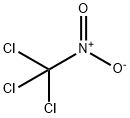Chloropicrin is a colorless to faint-yellow oily liquid with an
intensely irritating and sharp odor with characteristics of tear
gas. Some common trade names of products containing chloropicrin
include Dolochlor, Aquinite, Nemax, Pic-Chlor, Timberfume,
Profume A, Tri-Clor, and Microlysin. It has
a molecular weight of 164.38, water solubility of 2000 mg l�1
at 25°C, and melting and boiling points of �64 and 112°C,
respectively. Chloropicrin is nonflammable and has a vapor
density of 5.7 compared to the vapor density of one assigned to
air. Heating above 234 �F results in explosive decomposition of
chloropicrin, leading to the release of toxic gases, including
nitrogen oxides, phosgene, nitrosyl chloride, chlorine, and
carbon monoxide. Chloropicrin is a widely used fungicide that
is primarily used for preplant soil fumigation. Chloropicrin is
used to fumigate stored grain and to treat soil against fungi,
insects, and nematodes either as a stand-alone treatment or in
combination with other fumigants like methyl bromide and
sulfuryl fluoride for enhanced potency. Chloropicrin is also
used to prevent internal decay of wood poles and timber
caused by fungi and insects.

